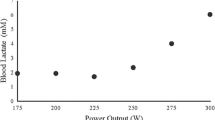Abstract
There is some evidence that, above anaerobic threshold (AT), the arteriovenous oxygen difference may increase due to a reduced hemoglobin affinity for oxygen. Thus, it should be expected that above AT, the oxygen consumption to cardiac output (VO2/CO) relationship would become steeper compared to below AT since, if a larger amount of O2 could be extracted from blood, a lower CO would be required for carrying the same O2 quantity. We tested the possibility that the VO2/CO relationship shows a break point after AT, becoming steeper. Cardiodynamics and expired gases were measured with an impedance cardiograph and a mass spectrometer in ten healthy male subjects during an incremental test on a cycle ergometer. We performed three linear regressions for each subject’s VO2/CO ratio: one for the entire exercise dataset, one for data below AT, and one for data above AT. Statistical comparisons of linear regressions obtained from VO2 and CO for below and above AT data failed to find any significant difference between these data. This study demonstrates that the slope of the VO2/CO relationship does not exhibit a break point at AT. Therefore, it seems that AT does not play a key role in affecting this relationship during incremental exercise.
Similar content being viewed by others
Author information
Authors and Affiliations
Corresponding author
Rights and permissions
About this article
Cite this article
Crisafulli, A., Melis, F., Tocco, F. et al. Anaerobic threshold and the oxygen consumption–cardiac output relationship during exercise. Sport Sci Health 1, 75–80 (2005). https://doi.org/10.1007/s11332-2005-004-0014-3
Received:
Accepted:
Issue Date:
DOI: https://doi.org/10.1007/s11332-2005-004-0014-3




